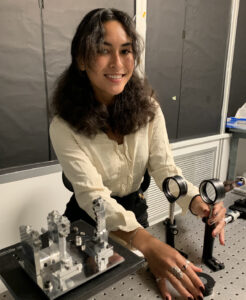
Grace was born and raised in Kohala on the Big Island of Hawaii, and currently resides in Cleveland, Ohio, where she studies Astronomy at Case Western Reserve University. Though the stars do not shine as bright in the city of Cleveland, she utilizes CWRU’s rooftop telescope as often as she can, so that she may revisit her oldest, closest friends whom she sees regularly back home. She hopes to share this love and knowledge of the universe with like-minded academics as a professor of Astronomy one day. When she isn’t stargazing, Grace is most likely finding seashells on the ocean floor, hiking to hidden waterfalls, or reclining on cliff sides.
Home Island: Big Island of Hawaii
High School:
Institution when accepted: Case Western Reserve University
Quantifying the Precision of SCALES’ Slenslit Unit through Optical Tests
Project Site: University of California Observatories, Santa Cruz, CA
Mentor: Renate Kupke
Project Abstract:
The goal of the SCALES (Slicer Combined with Array of Lenslets for Exoplanet Spectroscopy) instrument is to detect faint exoplanets via atmosphere composition by producing hyperspectral imaging. From these spatially resolved spectra, we will be able to distinguish, compositionally, exoplanets from surrounding objects, such as gas and dust surrounding a protostar. The Slenslit is an optical component of SCALES that combines the precise sampling capabilities of a lenslet array, allowing for minimal light aberrations, and the high-resolution spectroscopy of an optical slicer. The unit realigns light through a series of tilted and curved mirrors in order to arrange the array of light produced by the lenslet into a pseudo-slit: a distribution of light from which spectra may be produced from each point with optimal spacing and precision. The objective of this project is to conduct a series of optical tests at the University of California Observatories (UCO) to determine the distribution between points of the pseudo-slit generated by the Slenslit prototype, as well as the quality of the image produced, to ensure that required spatial and spectral resolution are achieved.